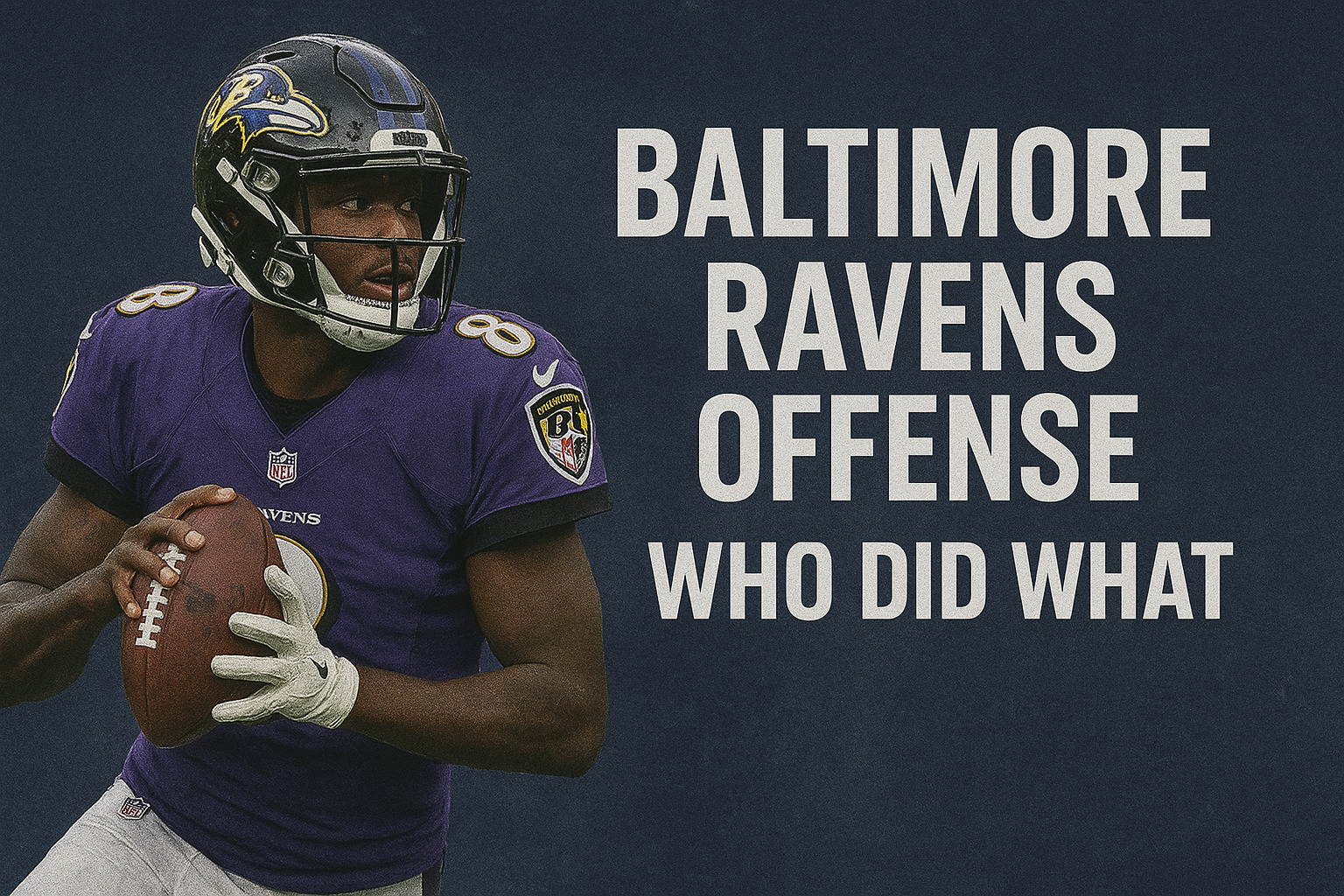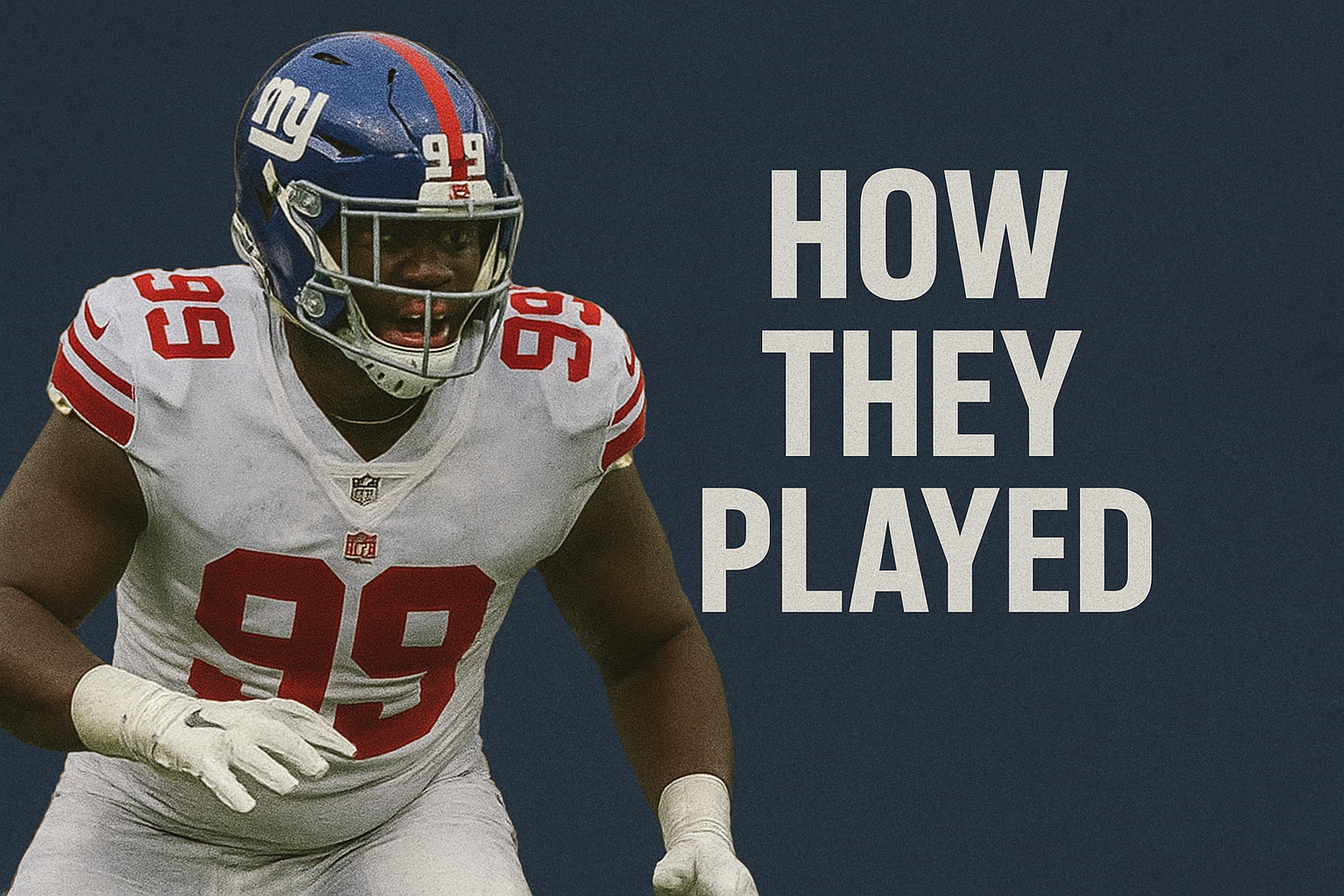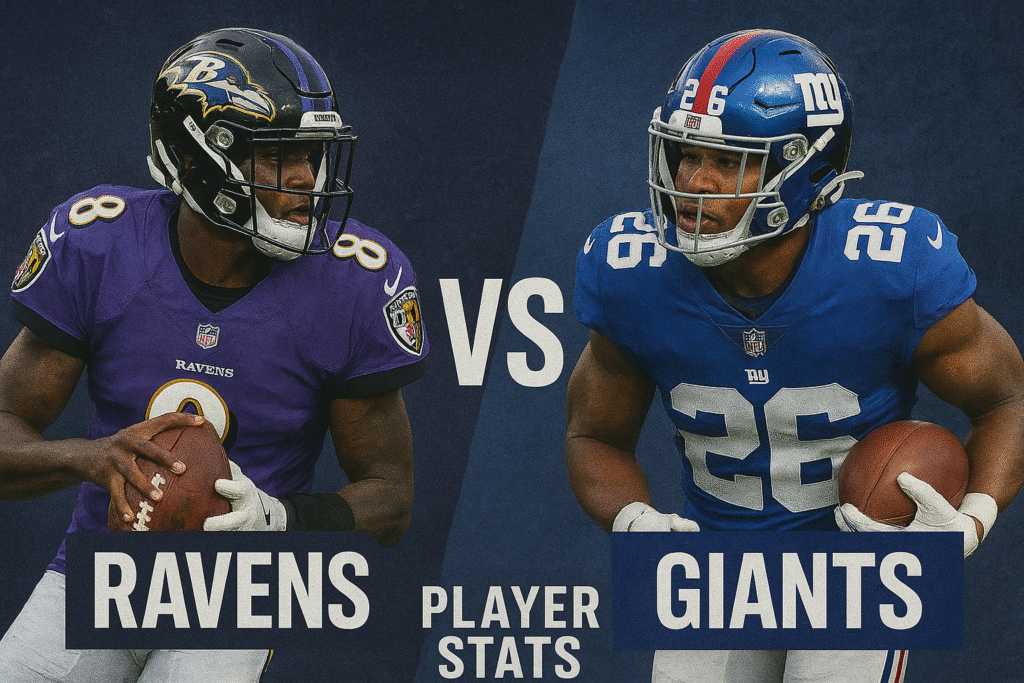So the Baltimore Ravens and New York Giants faced off, and if you’re here, you probably want to know exactly how each player did. Maybe you missed the game, or you’re checking fantasy stats, or you just love diving into the numbers. Whatever brought you here, I’ve got you covered with a complete look at who showed up and who didn’t.
This isn’t just another box score recap. We’re going deep into the player stats, talking about what actually happened on the field, and breaking down the performances that mattered most.
The Big Picture: How the Game Played Out
The Final Score and What It Tells Us
When the Ravens play the Giants, you usually get one of two things: either Baltimore’s offense explodes, or the Giants’ defense keeps things close and ugly. The score tells part of the story, but the stats tell us everything else.
Looking at the numbers, you can see which team controlled the game, who won the turnover battle, and where things went right or wrong. Time of possession matters. Red zone trips matter. Third downs matter. All of it adds up.
Where They Played and Why It Matters
Weather changes everything in football. If they played at M&T Bank Stadium or MetLife Stadium, the conditions affected how players performed. Cold weather? Expect more running. Windy? Good luck throwing deep balls. These details matter when you’re looking at quarterback accuracy or kicking stats.
Baltimore Ravens Offense: Who Did What

Lamar Jackson’s Numbers
Let’s start with the obvious one. Lamar Jackson is why people watch Ravens games. The guy can beat you with his arm or his legs, and the stats always reflect that.
His Passing Stats:
- How many passes he completed and his accuracy
- Total yards through the air
- Touchdowns vs interceptions
- How many yards he averaged per throw
- His passer rating
- How he did throwing deep (20+ yard passes)
- Stats when the defense was pressuring him
His Running Stats:
- Yards he picked up on the ground
- Average per carry
- Rushing touchdowns
- His longest run
- Which runs were designed vs scrambles
When Lamar’s running well, the whole offense flows differently. You can see it in the numbers.
The Running Backs
The Ravens running game usually involves a rotation. Gus Edwards, Justice Hill, or whoever got the carries – here’s what they did:
What to Look For:
- Total carries and yards gained
- Yards after getting hit (this shows how tough they ran)
- Catches out of the backfield (Ravens RBs catch passes too)
- Receiving yards
- Touchdowns, both rushing and catching
- Did they fumble? Ball security counts
- Average yards per carry
A good running back makes yards even when the blocking isn’t perfect. The stats show you who was doing that.
Pass Catchers: Wide Receivers and Tight Ends
The Ravens receiving numbers spread around usually, but someone always has a big day.
Top Receivers:
- How many catches each guy made
- Total yards
- Touchdowns
- Yards per catch average
- Yards after the catch (YAC)
- What percentage of targets they caught
- Catches in tight coverage
- How well they ran their routes
The Tight Ends: Mark Andrews is usually Lamar’s security blanket. Isaiah Likely’s been making plays too. Tight ends matter a lot for Baltimore, especially near the goal line.
Offensive Line
You don’t see offensive line stats on SportsCenter, but they matter:
- How many sacks did they give up?
- Quarterback pressures allowed
- Pancake blocks (when they flatten defenders)
- How well they opened holes for runners
Baltimore Ravens Defense: The Numbers
Defensive Line Performance
The Ravens defense starts up front. These big guys set the tone.
What They Did:
- Total tackles
- Sacks on the quarterback
- Hits and pressures even without sacks
- Tackles for loss (stopping plays in the backfield)
- Stuffing runs at the line
- Batting down passes
Linebackers
Ravens linebacker stats usually jump off the page. These guys are everywhere.
Patrick Queen and Roquan Smith (or whoever started):
- Total tackles (solo and assisted)
- Sacks and pressures
- Passes broken up
- Interceptions and forced fumbles
- Coverage assignments and how they did
- Run stopping percentage
Good linebackers show up in every stat category. That’s what makes them good.
The Secondary
Ravens defensive backs had to cover Giants receivers all game. Here’s how they did:
Cornerback Numbers:
- Passes defended
- Interceptions (and pick-sixes if they got one)
- Completion percentage when thrown at
- Yards allowed in coverage
- Tackles they made
- Success rate in press coverage
Safety Stats:
- Tackles and coverage numbers
- Interceptions and turnovers forced
- Help in run defense
- Preventing big plays downfield
New York Giants Offense: Their Numbers
The Giants Quarterback
Giants QB stats depend on who played – Daniel Jones or someone else:
Passing Numbers:
- Completion percentage
- Total passing yards
- Touchdown throws
- Interceptions
- Times he got sacked
- Yards per attempt average
- How he played in the fourth quarter
Running Stats:
- Rushing yards (quarterbacks run too)
- Success rate on scrambles
- Yards lost on sacks
Giants Running Backs
The Giants running game could feature Saquon Barkley or their current backs:
Running Back Stats:
- Total carries and yards
- Yards per carry
- Longest run
- Catches and receiving yards
- Touchdowns scored
- Broken tackles (this shows power)
- Yards after contact
Great running backs make something out of nothing. The numbers prove it.
Giants Receivers
Giants wide receiver stats show you who the quarterback trusted:
Pass Catchers:
- Catches per player
- Yards gained
- Touchdowns
- Average per catch
- How many targets they got
- First downs converted
- Did they drop passes?
Tight End Numbers
Giants tight ends help in blocking and catching. Guys like Darren Waller or Daniel Bellinger contribute in both areas.
New York Giants Defense: How They Played

The Defensive Line
The Giants defensive line had to slow down Baltimore’s offense:
Their Stats:
- Total sacks
- Quarterback hits
- Tackles for loss
- Run defense grades
- Pass rush success rate
- How they handled double teams
Linebackers
Giants linebacker stats show their ability to stop the run and cover:
Key Numbers:
- Total tackles
- Sacks and pressures
- Passes defended
- Blitz effectiveness
- Gap discipline (staying in position)
Giants Secondary
The Giants defensive backs faced a tough test against Baltimore’s passing game:
DB Stats:
- Interceptions and passes defended
- Completion percentage allowed
- Yards after catch given up
- Tackles in space
- Coverage grades
Special Teams: Kickers, Punters, and Returners
The Kicking Game
Field goals and extra points for both teams:
Ravens Kicker:
- Justin Tucker’s field goal percentage (he’s usually automatic)
- Longest field goal
- Extra point success
- Touchbacks on kickoffs
Giants Kicker:
- Field goal makes and misses
- Extra point percentage
- Clutch kicks in pressure moments
Punting Stats
Punter numbers:
- Average yards per punt
- Punts inside the 20
- Longest punt
- Net average (accounts for returns)
- Hang time
Return Game
Kick and punt returns:
- Average yards per kickoff return
- Average yards per punt return
- Longest return
- Any return touchdowns
- Fair catches vs actual returns
Head-to-Head: Who Won Their Battles
Quarterback Comparison
Putting the two quarterbacks side by side shows you who played better and managed the game smarter.
Running Game Battle
Ravens vs Giants on the ground:
- Total rushing yards each team
- Yards per carry average
- Rushing touchdowns
- Longest runs
Defensive Matchups
Individual battles:
- Ravens pass rush vs Giants offensive line
- Giants pass rush vs Ravens protection
- Cornerbacks vs wide receivers
- Linebacker run stopping
What the Stats Really Show
First Half vs Second Half
How things changed:
- Scoring by quarter
- Offensive efficiency trends
- Defensive adjustments that worked
- Fourth quarter performances
Third Down and Red Zone
Critical situations:
- Third down conversion rates
- Third down stops by defense
- Red zone touchdowns vs field goals
- Red zone defensive stands
The Turnover Battle
Who protected the ball:
- Total turnovers each team
- Points scored off turnovers
- Momentum shifts from turnovers
- Ball security grades
Fantasy Football Impact
Top Fantasy Scorers
Who helped your fantasy team:
- Highest PPR scorers
- Standard scoring leaders
- Surprise performers
- Players who disappointed
What This Means Going Forward
Fantasy takeaways:
- Who to start next week
- Trending players to watch
- Injury impacts on value
- Matchup considerations
Ravens vs Giants: The History
Series Record
Historical numbers:
- Overall record between these teams
- Average points scored historically
- Best past performances
- Any playoff meetings
Franchise Records
Individual game records:
- Best passing games in this matchup
- Top rushing performances
- Defensive records
- Special teams highlights
Game-Changing Moments
Plays That Mattered Most
Statistically important plays:
- Plays that swung win probability
- Turnovers that changed momentum
- Crucial third or fourth down conversions
- Performances that sealed the game
Advanced Numbers
Next-level stats:
- Expected points added (EPA)
- Success rate on plays
- Win probability changes
- Air yards vs yards after catch
- Average time to throw
- Pressure rates
Injuries and Their Impact
Pre-Game Injuries
How missing players affected stats:
- Key players who didn’t play
- Limited snaps for injured guys
- Backup performances
- Depth chart changes
In-Game Injuries
Statistical impact of injuries during the game:
- Players who left early
- Stats before and after injuries
- How backups stepped up
Coaching Decisions and Stats
Play Calling
Offensive coordinator choices:
- Pass to run ratio
- Which personnel groups worked
- Success in key situations
- Risky vs safe decisions
Defensive Schemes
Defensive coordinator strategies:
- How often they blitzed
- Coverage schemes used
- Run-stopping formations
- Pressure packages that worked
What These Stats Tell Us
The Big Takeaways
Key insights:
- Most impressive performances
- Surprising stats
- Where each team dominated
- What to expect in future matchups
Beyond Just Numbers
Context matters:
- Quality of opponent
- Scheme advantages
- Matchup-specific performances
- Stats that will continue vs flukes
Looking Ahead: Playoff Implications
How This Affects the Playoff Race
Postseason impact:
- Division standings changes
- Wildcard positioning
- Head-to-head tiebreakers
- Statistical trends for playoff teams
Player Growth
Development trends:
- Young players emerging
- Veterans staying consistent
- Position groups improving
- Areas needing work
Final Thoughts
The Baltimore Ravens vs New York Giants player stats tell the whole story of this game. From Lamar Jackson’s playmaking to the Giants’ defensive effort, every number means something.
What Mattered Most:
- Ravens offensive efficiency
- Giants defensive highlights
- Individual standout performances
- Game-changing plays
- What this means going forward
Game MVPs
Best performers:
- Offensive player of the game
- Defensive player of the game
- Special teams standout
- Unsung heroes
This breakdown gives you everything you need to understand what happened in this Ravens vs Giants matchup. Whether you’re checking fantasy numbers or just love football stats, these numbers paint the complete picture.
Common Questions
Where can I find live Ravens vs Giants stats?
Check NFL.com, ESPN, or the team websites for real-time player stats during games.
How does weather affect player performance?
Wind hurts passing and kicking. Rain makes catching and holding the ball harder. Cold weather usually means more running plays.
What stats matter most in Ravens vs Giants games?
Watch quarterback play, turnovers, third down conversions, sacks, and red zone performance for the best picture.
How often do these teams play?
They’re in different conferences, so they meet about once every four years in regular season unless they make the Super Bowl.
Which players usually do well in this matchup? Ravens quarterbacks and running backs typically have good games because of Baltimore’s offensive style. Giants defensive linemen often get good pressure numbers.
